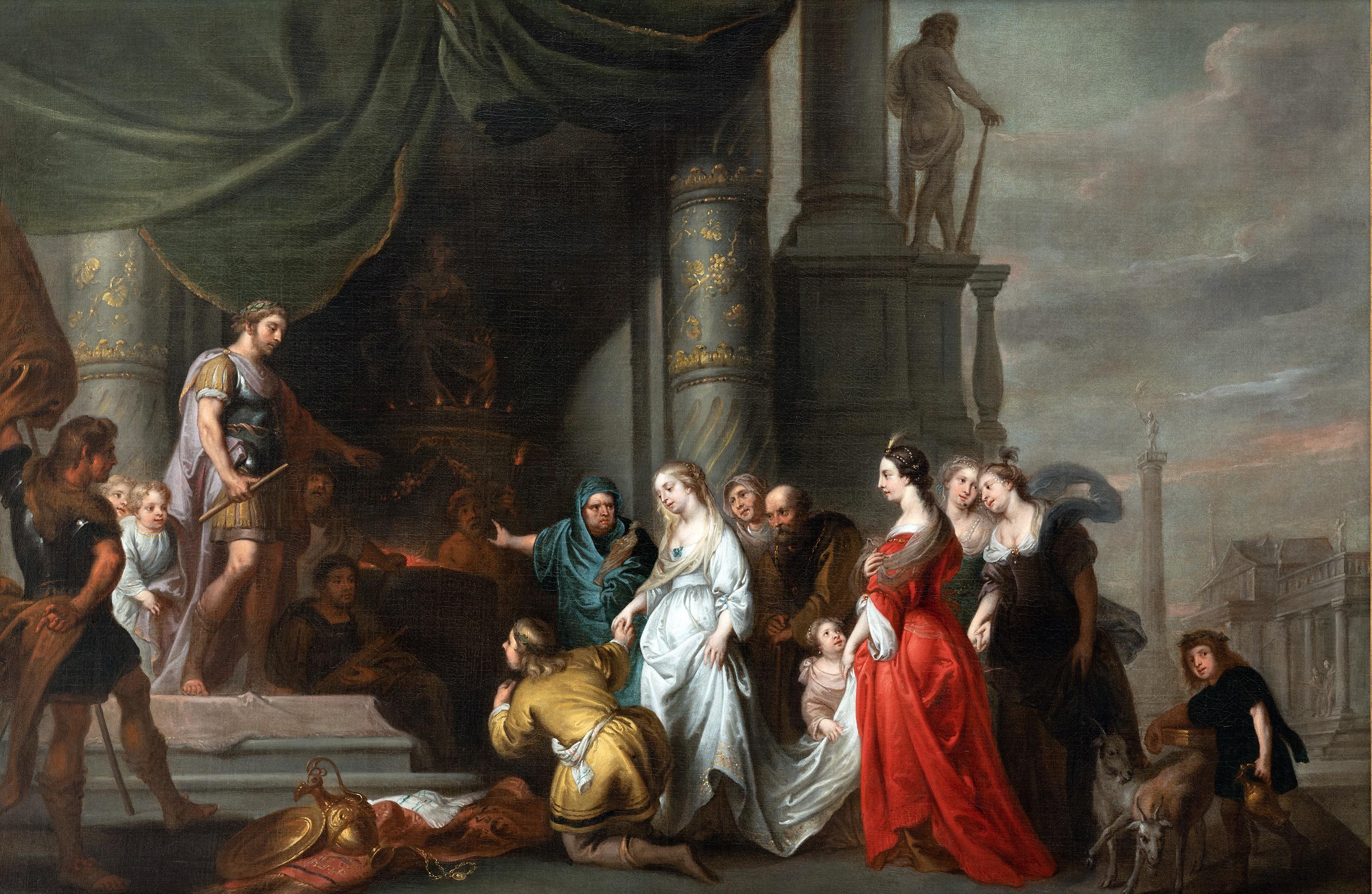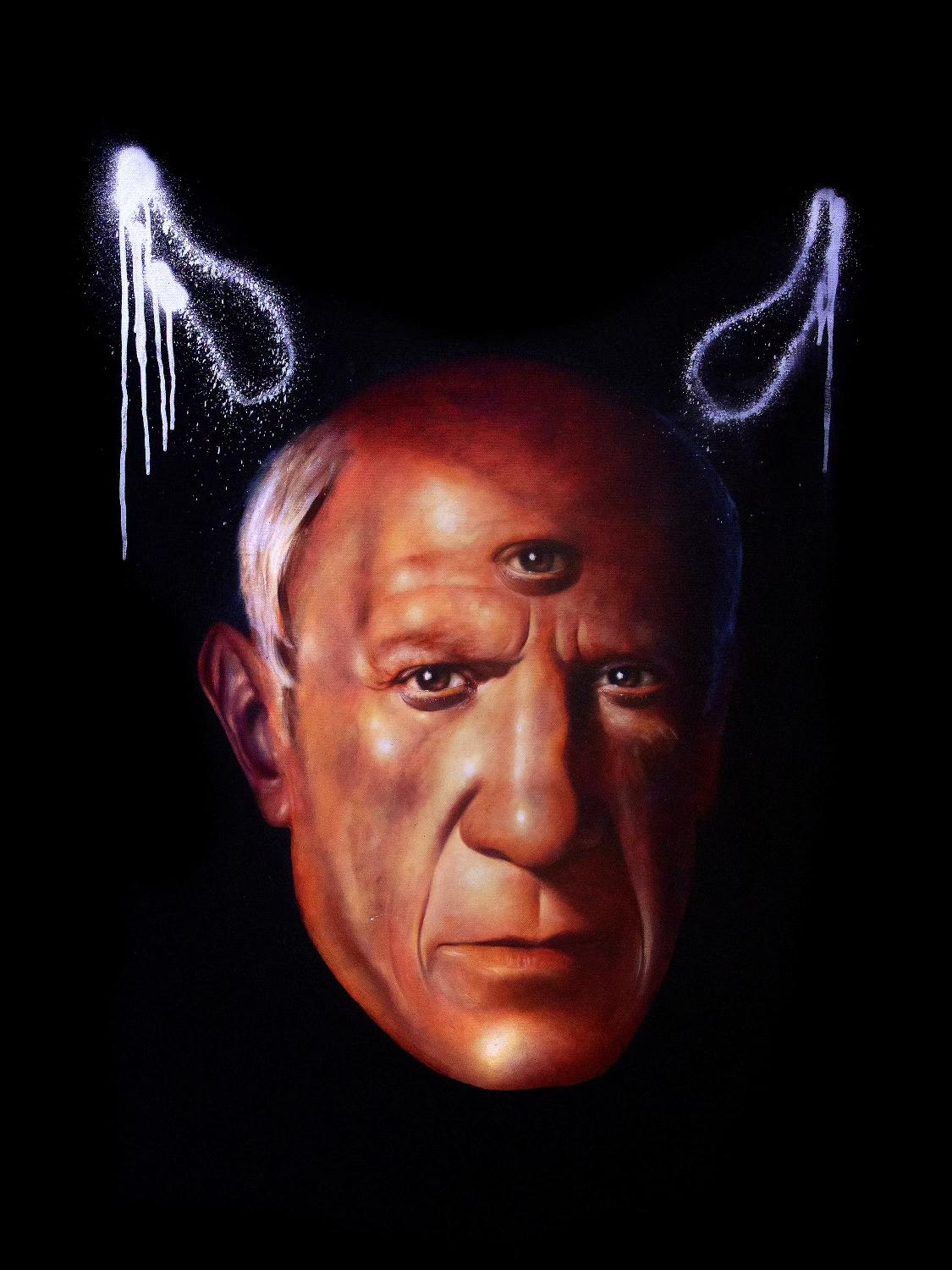Items Similar to Testa di Vecchio
Want more images or videos?
Request additional images or videos from the seller
1 of 7
Francesco Fracanzano Testa di Vecchio
About the Item
Francesco Fracanzano (Monopoli 1612-Napoli 1656)
Testa di vecchio
Olio su tela, cm 66x52,5
La tela presenta la figura di un uomo anziano a mezza figura con lo sguardo
rivolto verso sinistra, ritratto su un fondo scuro, colto in un'espressione di
sofferenza e di dolore, ripreso con le mani congiunte in atto si preghiera. I
caratteri stilistici dell'opera basati su un contrastato incarnato, una forte
accentuazione dell'espressione sofferente efficacemente espressa dal punto di
vista luministico, la minuta descrizione dei particolari del volto, dalla folta
barba bianca sapientemente descritta, fino all'aggrottarsi della pelle del viso
in cui si notano due piccole gocce di lacrime, riconducono a modelli di santi e
profeti eseguiti a mezze figure elaborati nel Seicento a Napoli da Jusepe
Ribera, qui tradotti in forme alquanto espressive ed efficaci. L'iconografia del
dipinto potrebbe suggerire che possa trattarsi dell'effigie di un santo (San
Pietro?), ma anche di un filosofo, emaciato nelle carni, scavato nel volto da
profonde rughe, con uno sguardo nobile e profondo. La rappresentazione di
mezze figure di santi e filosofi fu una moda nata proprio nella bottega di
Ribera nella capitale partenopea e diffusasi poi anche in provincia grazie ai
suoi numerosissimi allievi, tra i quali si ricordano Massimo Stanzione o
Francesco Fracanzano. Ed è proprio a quest'ultimo che il dipinto va riferito se
posto a confronto con le sue numerose composizioni intonate sullo stesso
soggetto e che presentano un identico ductus pittorico. Si confronti ad esempio l'anatomia del volto del presente dipinto con il San Pietro del Museo di Capodimonte di Napoli
(efr. Battistello Caracciolo e il primo naturalismo a Napoli. Catalogo della mostra, a cura di F. Bologna, Napoli 1991, p. 341, n. 2.117) o quello sempre di San Pietro in una collezione privata di Reggio Emilia (Fig.1); per una rassegna della sua produzione, si veda A. Della Ragione, Francesco Fracanzano, Opera completa, Napoli 2011). L'aspetto più
saliente dell'opera è la decisa accentuazione della cromia del volto dai forti
contrasti tonali, così come anche nella veste che rende l'opera alquanto
interessante e particolare e che va inserita senza dubbio nell' orbita della
produzione del pittore napoletano, annoverandosi tra le prove meglio
riuscite, da datarsi intorno agli anni cinquanta del Seicento.
//
Francesco Fracanzano (Monopoli 1612-Naples 1656)
Head of an old man
Oil on canvas, 66x52.5 cm
The canvas presents the figure of a half-length elderly man with a look
facing left, portrayed against a dark background, caught in an expression of
suffering and pain, taken up with hands joined in prayer. THE
stylistic characters of the work based on a contrasting complexion, a strong one
accentuation of the suffering expression effectively expressed by the point of
luministic view, the minute description of the details of his face, from the thick one
wisely described white beard, up to the wrinkling of the skin of the face
in which two small drops of tears are noticed, they lead back to models of saints and
prophets executed in half figures elaborated in the seventeenth century in Naples by Jusepe
Ribera, here translated into quite expressive and effective forms. The iconography of the
painting could suggest that it may be the effigy of a saint (San
Pietro?), But also of a philosopher, emaciated in the flesh, hollowed out in the face by
deep wrinkles, with a noble and deep look. The representation of
half figures of saints and philosophers was a fashion born in the workshop of
Ribera in the Neapolitan capital and then spread also in the province thanks to
his numerous pupils, among which Massimo Stanzione o
Francesco Fracanzano. And it is precisely to the latter that the painting must be referred to
compared with his numerous compositions sung on the same
subject and presenting an identical pictorial ductus. For example, compare the anatomy of the face of this painting with the San Pietro of the Capodimonte Museum in Naples
(cf. Battistello Caracciolo and the first naturalism in Naples. Catalog of the exhibition, edited by F. Bologna, Naples 1991, p. 341, n. 2.117) or that of San Pietro in a private collection in Reggio Emilia (Fig. 1); for a review of his production, see A. Della Ragione, Francesco Fracanzano, Complete work, Naples 2011). The more aspect
salient of the work is the decisive accentuation of the color of the face by the strong
tonal contrasts, as well as in the dress that makes the work somewhat
interesting and particular and that must undoubtedly be inserted in the orbit of the
production of the Neapolitan painter, counting among the best proofs
successful, to be dated around the fifties of the seventeenth century.
- Creator:Francesco Fracanzano (1612 - 1656, Italian)
- Dimensions:Height: 35.44 in (90 cm)Width: 30.71 in (78 cm)Depth: 2.37 in (6 cm)
- More Editions & Sizes:90x78x6Price: $43,883
- Medium:
- Movement & Style:
- Period:
- Condition:
- Gallery Location:Balerna, CH
- Reference Number:1stDibs: LU2122210888442
About the Seller
No Reviews Yet
Vetted Seller
These experienced sellers undergo a comprehensive evaluation by our team of in-house experts.
Established in 2013
1stDibs seller since 2022
- ShippingRetrieving quote...Ships From: Balerna, Switzerland
- Return PolicyA return for this item may be initiated within 7 days of delivery.
More From This SellerView All
- Andata al calvarioBy Sebastiano MazzoniLocated in Balerna, TISebastiano Mazzoni Andata al calvario Olio su tela, Sec. XVI, cm 130x143; con cornice 167x153x9 Il dipinto rappresenta un episodio della Passione di Cristo cui accennano appena i Van...Category
17th Century Baroque Interior Paintings
MaterialsCanvas, Oil
You May Also Like
- G Negri called Il Boccia Baroque Figurative Painting 17th century oil canvasBy Girolamo Negri called Il BocciaLocated in Florence, ITOil on canvas, 62 x 51 cm (without the frame) Even if on the background there is an attribution to “Francesco Gessi pupil of Guido Reni” by the bolognese art historian Guido Zucchini (dated 1945), recent studies are tending to add it to the corpus of Girolamo Negri called Il Boccia (Bologna 1648-1718) due to lots of similarities with his style (the pale and warm palette chosen, the profile) The painting represents a lady on profile wearing a brown turban, a yellow clock...Category
Late 17th Century Baroque Figurative Paintings
MaterialsCanvas, Oil
- Ritratto figurativo maschile scuola toscana del XVII secolo olio su telaLocated in Florence, ITDipinto di scuola toscana della seconda metà del XVII secolo raffigurante un ritratto maschile di tre quarti, immerso nell'eleganza e nella maestosità proprie dell'epoca. La figura è...Category
Late 17th Century Baroque Portrait Paintings
MaterialsCanvas, Oil
- Continence of Scipio, Erasmus Quellinus, School Rubens, Baroque Art, Old MasterBy Erasmus Quellinus the YoungerLocated in Greven, DEErasmus Quellinus The Continence of Scipio Oil on Canvas The painting is included in the Catalogue Raisonné of the artist. The Roman commande...Category
17th Century Baroque Figurative Paintings
MaterialsOil, Canvas
- "WALT" Painting 48" x 36" inch by Isaac PelayoBy Isaac PelayoLocated in Culver City, CA"WALT" Painting 48" x 36" inch by Isaac Pelayo Medium: oil and aeorosl on canvas ABOUT THE ARTIST: Isaac Pelayo is a head on crash collision between The Renaissance and Street Art...Category
21st Century and Contemporary Baroque Portrait Paintings
MaterialsOil, Spray Paint, Canvas
- Portrait of Giovanni Morosini (1719 - 1789), Italian school. Late 18th centuryLocated in Firenze, ITPortrait of Bishop of Verona Giovanni Morosini (1719 - 1789), Italian school. Technique: oil on canvas painting, relined canvas. Late 18th century. Represents a church man. The fig...Category
Late 18th Century Baroque Portrait Paintings
MaterialsCanvas, Oil
- "PABLO" Oil Painting 48" x 36" inch by Isaac PelayoBy Isaac PelayoLocated in Culver City, CA"PABLO" Painting 48" x 36" inch by Isaac Pelayo Medium: oil and aeorosl on canvas ABOUT THE ARTIST: Isaac Pelayo is a head on crash collision between The Renaissance and Street Ar...Category
21st Century and Contemporary Baroque Portrait Paintings
MaterialsCanvas, Oil, Spray Paint




